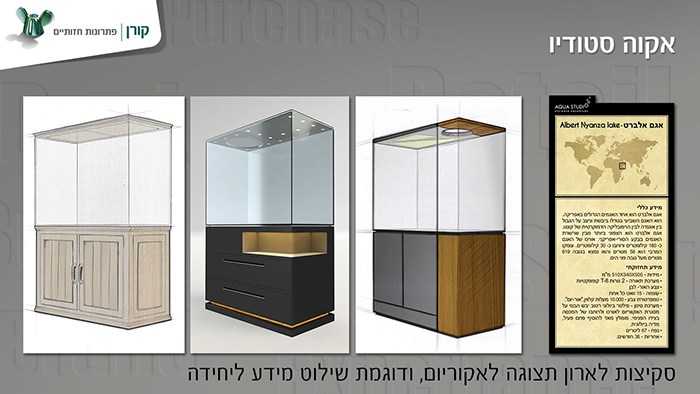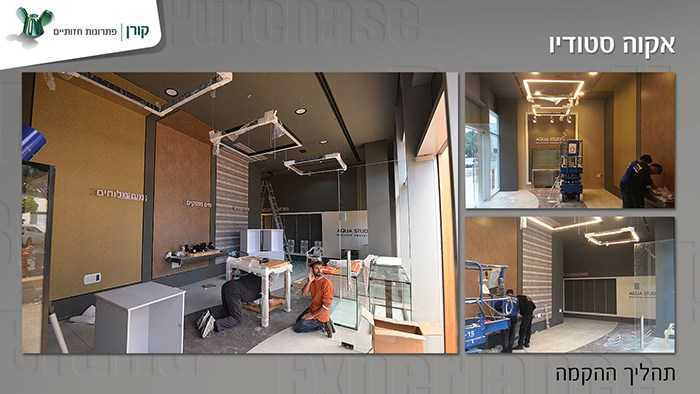The importance of marketing ideas in the design and planning of points of sale and how definitively these can impact a store’s performance and success.
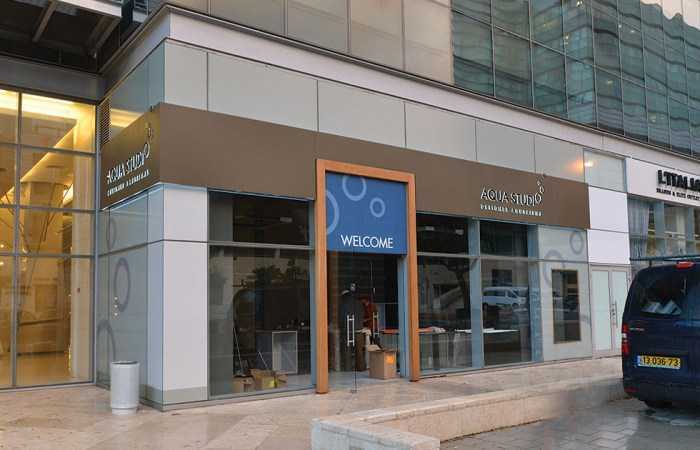
A retail outlet’s commercial success is measured by parameters such as revenue per square meter, the number of customers per day and customer repeat visits. These parameters are more important than a how the store looks and the shopping experience itself, and they are what determine retail success and long-term survival.
Before the internet and the last decade’s technological revolution, the store was the customer’s only option for shopping. Good design was enough to make a store appealing. Today, physical stores are just one shopping alternative. To attract customers and generate a high volume of sales, stores must be smart, precise and planned carefully with marketing perspective.
Macy’s wasn’t packed on Black Friday [image 1] due to meticulous planning and design but because Black Friday in recent decades has become America’s biggest shopping day and opens the Christmas retail season. I doubt whether customers enjoy shopping on Black
Friday . . . .
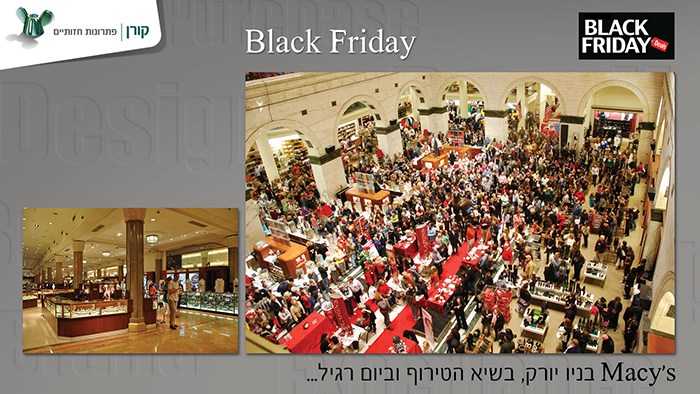 Macy’s in New Yorkthe height of Black Friday madness; and a regular day.
Macy’s in New Yorkthe height of Black Friday madness; and a regular day.Cyber Monday, which follows Black Friday, is an even bigger shopping day, all online. On Cyber Monday, many online shopping websites offer significant discounts and sales volumes are enormous.
Online sales are growing steadily and online shopping is now the preferred alternative in many categories.
In a British market analysis conducted in May 2014, in some retail categories the majority of sales are now online [image 2] Topping the list are music and videos at around 80%, books at 53%, and electronics at 42%. Other categories will likely take longer for online volumes to reach these levels, but the trend is clear [image 2].
 Growth of internet shoppingMusic, books and electronics are the leading categories in online shopping
Growth of internet shoppingMusic, books and electronics are the leading categories in online shoppingThe last decade has been, in my opinion, the most interesting and fascinating. It is a challenge to be part of a period of such movement after decades of slow development in the field. There are two main forces affecting the current retail world. One is technology, which is changing the products and creating online stores and social networks. The second force is social and fashion trends, these same social networks and networking activities, which determine consumer trends. These forces are changing and evolving at an increasingly high rate, feed back into one another, and are forcing standard stores to face a new standard of competition [image 3].
 Influences in retail over the past decadeTechnology, trends, regulation and politics.
Influences in retail over the past decadeTechnology, trends, regulation and politics.As I understand it, we are the first stages of a retail revolution. The retailer is responsible for staying relevant and up-to-date [image 4]. Physical stores will likely maintain their position in the long run, but alternatives are rapidly developing and threaten anyone who fails to keep up. We all know, for example, what happened to photography stores of the 1990s that failed to transition to the world of digital photography in time.
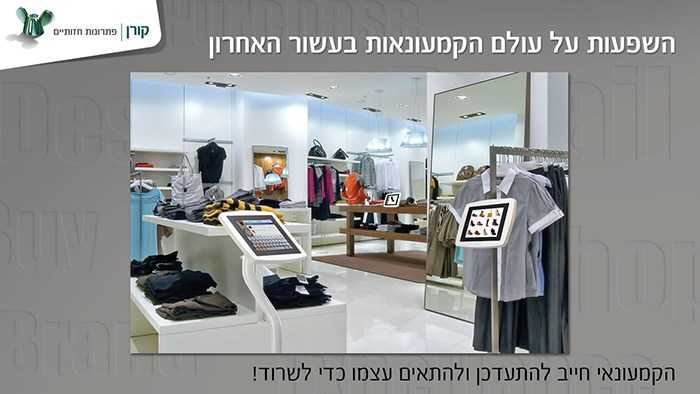 Influences in retail over the past decadeRetailers must stay up-to-date and adapt to survive!
Influences in retail over the past decadeRetailers must stay up-to-date and adapt to survive!Online stores have considerable advantages over physical stores. Content, products, prices, categories and locations can be easily changed online, and products and sales are easier to promote; retail errors are simpler to correct online; online stores have a better chance of gaining international exposure, and can easily offer customized content for each customer, all of which will maximize sales. Traditional stores do not have these capabilities. Changing the product range, display, checkout counter, etc. in an independent store, not to mention a chain, can take days or even weeks, requires a financial investment and may require contractors.
In many stores, not every square meter functions optimally, and not every area in the store has the same level of importance. This is true for different periods of time or for the entire life of the store, and due to costs and objective difficulties, large areas of retails spaces continue to be used inefficiently.
In addition, not all retail areas are perceived by most customers as being essential and having the same level of importance. Retail areas can be divided into sites that a customer uses because of a need (such as gas stations, pharmacies, etc.), places the customer wants to experience (such as markets, tourist shops, duty free stores, etc.) and impulse stores that may be in any category, but that the customer will not necessarily visit.
Truths of tradition retail should be critically re-examined. In the 1990s, the rule of thumb for everyone was that “70% of the buying decisions occur at the point of sale.” (Paco Underhill in his bestseller Why We Buy). Is this still true? Customers today, even before they enter the store, may know more about a specific product than the salespeople.
Likewise, consumers are now “showrooming” before they buy. Customers visit a physical store to see the product and try it on, but then buy the product more cheaply online. The result is that certain stores have become little more than fitting rooms or places to try out products, which is harming their revenues.
Inventory and availability are now more important than in the past – “It’s out of stock, try again in a week,” is simply unacceptable to customers and they may look for alternative shopping options, which was not possible before.
Customers have adapted quickly to easy shopping and are willing to give up a lot for it. Take, for example, cameras: they have largely been abandoned in favor of inferior cell phone photography; many people prefer eating prepared food to cooking; and many customers will settle for the nearest gas station even if it is not the cheapest. The same goes for shopping at a store – many customers feel that it is a time-wasting inconvenience, and prefer to shop online.
About 15 years ago, there was a fear that the internet, DVD-burners and cable TV would kill movie theaters and, indeed, many theaters were closed or torn down. The subsequent movie theater renaissance has stunned every expert, though it was enabled by significant changes in the theaters themselves. Today, a movie theater must be more than just attractive and comfortable. They also must be an attraction in and of themselves and must be built to the highest standards. Theaters have been built that incorporate innovative technology combined with updated content, to create an inclusive experience that includes restaurants, shopping and recreation. Ticket sales are now higher than ever before. To overcome the challenges in retail, perfection is needed not only in design, but in every detail of the shopping experience to create value and maximize retail efficiency.
My professional development in the field of visual merchandising during the late 1990s was in the framework of providing services to trade-marketing departments for local and international brands [image 5]. The success of my projects was measured by the increase in sales of a product on a specific shelf or fixture. Over the years, when I began to handle entire retail spaces (stores, supermarkets, kiosks, etc.) my own perspective on space remained unconventional within the interior design industry. Beyond understanding the customer and space constraints, I tend to look at the sales space from the perspective of the product, and see the line from the product to the customer from a distance, even before the customer enters the store.
 Presenting the brand at the point of saleDisplay fixtures for different brands, the goal – to increase brand sales in the store
Presenting the brand at the point of saleDisplay fixtures for different brands, the goal – to increase brand sales in the storeEverything on the path – whether signage systems, sales fixtures, sales staff, etc. – are all elements whose only purpose is to attract customers to and sell the product. I see myself as a salesman who uses the fixtures and space to sell products instead of words. The way I see it, the design of a store or a display fixture must be meticulous and comprehensive, down to the smallest details, which is essentially design and planning of every centimeter, not every meter.
As an industrial designer, I see almost everything in life as a product with a purpose. To me, a store is a large machine with many components that each have a different role to play, and when the machine’s output is a satisfied customer with a purchased product there is a greater chance that the customer will return to the same store. The designer and planner of a space are responsible for creating the right line between the product and the customer to close the deal, by neutralizing distractions and drawing customers from the outside into the store. My tools are meticulous planning of a store’s layout, fixtures, placing products, enhancing the feeling of that a product is valuable and lowering barriers.
When we plan a store, we sometimes must also change the mix of products, the packaging and the branding to conform to a standard, and generate the uniformity that is crucial in the sales process. Keep in mind that retail design is mainly intended for people on the move, and that messages must be conveyed quickly, with emphasis on orientation and high availability (in contrast to the design of a restaurant or hotel where the intention is for customers to slow down and spend time).
Retailers do not always have the knowledge or the budget for commercial consultants. Therefore, when we work on projects with architects or entrepreneurs, and are given the authority of finalizing the retail concept prior to the design, we focus on every detail in the store to make decisions and integrate systems that do not usually fall under the rubric of interior design and architecture. The process is similar to checking diagonals during construction after the plans, measurement, length of walls, the angles, both diagonals – the result is either accurate or not.
You can point to the astonishingly beautiful projects in Israel and abroad where it is clear that design and planning affected sales and explicitly abetted the sales effect. You can also find equally spectacular stores that fail the revenue parameter to the point that the stores close. Does this have something to do with the designer? To answer this question I bring an example from the world of advertising.
In 2007, following the success of similar beers abroad (e.g. Bud Light), Tempo launched its version of a low-alcohol beer: Goldstar Light [image 6]. The beer was pulled from the shelves after only three months, and the blame was directed at the creative director who chose Moshe Datz as the face of Goldstar Light, an actor the average man has trouble identifying with. Creative decisions and design clearly have consequence
 The creative director influences a brand’s success or failureGoldstar Light - the ad won applauds but the product never took off
The creative director influences a brand’s success or failureGoldstar Light - the ad won applauds but the product never took offThere is no doubt that the retailer has a weighty responsibility in choosing the right location for the store, the quality of the products and service, pricing, ongoing maintenance, inventory management and quality of the store’s human resources. The designer, however, is responsible for forming the concept, develop the right “narrative”, the planogram, plan the customer’s route and the brand’s look, plan a display system that is easy to operate and maintain and to create the right shopping experience. If the retailer makes incorrect decisions, including deficiencies in maintenance and management, the business’s success may be compromised. Errors made in forming the concept, design and planning can cause damage, and make routine operation difficult. The retailer, together with the space designer are partners in the success of the business.
For projects in which we are involved, usually turnkey projects, we act as special advisors and one of our main objectives is to almost entirely negate the need for highly-trained salespeople. Every retailer will tell you that the hardest thing to find is not the store space or the product, but rather good salespeople. Therefore, the basic principle in planning the store is to rely on an excellent sales system, if you cannot place a great salesperson next to each product. The designer must be precise and carefully plan every action and decision and there is no component that is less important than others, regardless of size and cost. Any error in the sequence between the customer and the product (placement/color/inappropriate font) may break the continuity, lose the customer’s attention and torpedo the closing the transaction.
For example, consider the checkout area at the Hazi Hinam grocery store chain [images 7-8]. The space looks impressive and provides the customer with an experience, but its success was that the design accounted for the position, placement and angle of every type of product, as well as the background and lighting, which led to dramatically increased sales in the checkout area. Detailed design alongside a focus on every detail of the display fixtures is critical in stores jam-packed with products like kiosks, pharmacies, food stores, etc.
 Hazi Hinam Supermarket Chain – Checkout CountersA retails success implemented in all the chain’s stores
Hazi Hinam Supermarket Chain – Checkout CountersA retails success implemented in all the chain’s stores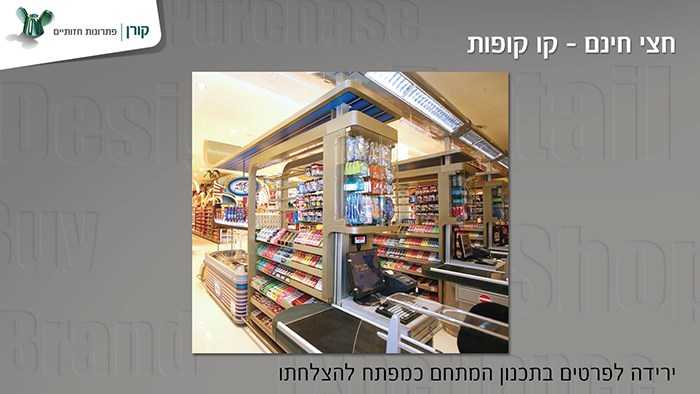 Hazi Hinam Supermarket Chain – Checkout CountersAttention to every detail is the key to the space’s success
Hazi Hinam Supermarket Chain – Checkout CountersAttention to every detail is the key to the space’s successSometimes a title like “the shopping experience” overwhelms the focus and, instead of a tool, it becomes the value. People enjoy being in the store but do not buy anything.
The shopping experience is the sum-total of all technical and retail decisions made in the project wrapped in a narrative that matches the values of the product or service offered to the customers; with this combination we get the same authenticity, or more precisely an imitation of authenticity, which is the key to getting the consumer to make a purchase.
No one expects a real spices stand to sprout in the middle of a commercial area [image 9], but the combination of the right messages combined with the right service and the proper professional packaging gives the customer a feeling of “the right moment to buy.” This is one of the most recognizable spaces in Israel for square footage of spices and dried fruits.
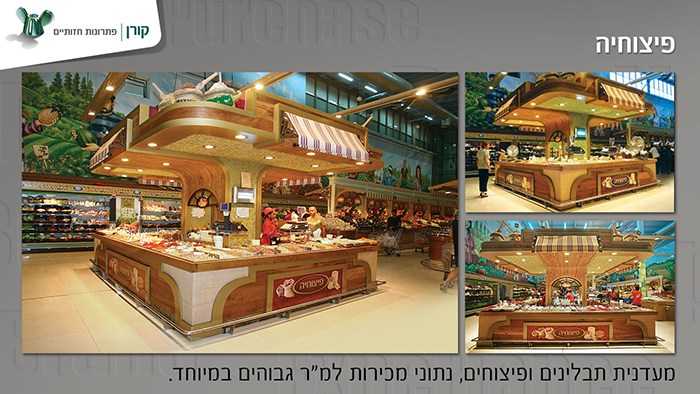 Nuts and Dried Fruit StandStand for spices and nuts, particularly high sales data per square meter
Nuts and Dried Fruit StandStand for spices and nuts, particularly high sales data per square meterThe design of a retail space cannot deviate from the perfect narrative, even if it is a fiction. The largest authentic forgery is Disneyland, where a human hand protruding from Mickey Mouse would ruin the story for adults, as well. In the same way, if an actor portraying a biblical character wears a wristwatch it will destroy scene’s credibility. It’s the same with a store – any unnecessary or incorrect component, however marginal, may distract the shopper, even unconsciously, and will affect revenue.
I decided to present work on a project work that illustrates all the phases of insight in the development of a retail space
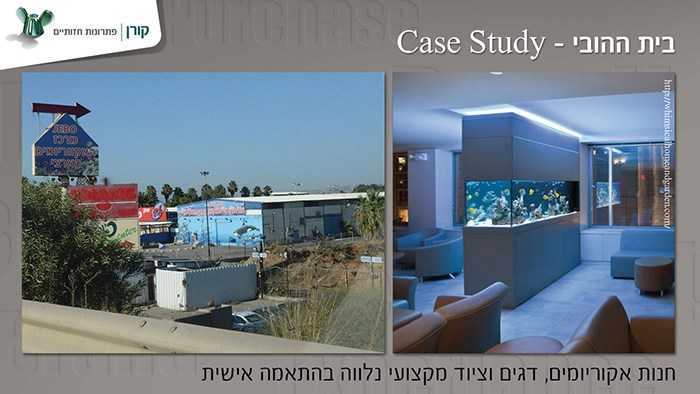 Hobby House – Case StudyA store selling customized aquariums, fish and professional equipment
Hobby House – Case StudyA store selling customized aquariums, fish and professional equipment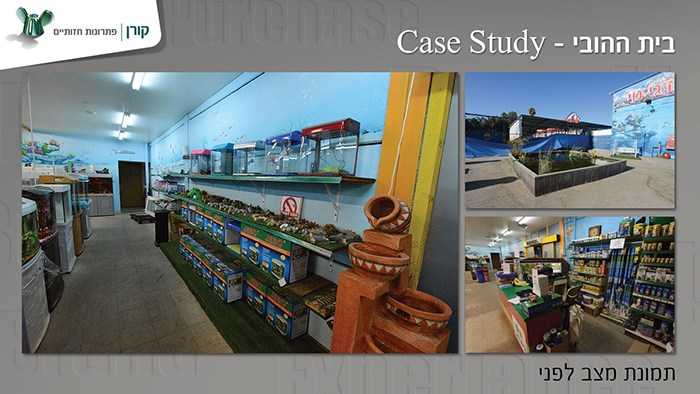 Hobby HouseBefore pictures
Hobby HouseBefore picturesI worked on a professional business in biological aquariums, called “The Hobby House” [“Beit Ha’Hobby”] in Petach Tikva.
The initial analysis was the gap between the aesthetic quality of the product and the space in which it was displayed.
The retailer offers packages of designed aquariums for homes or businesses, which include the entire contents of the aquarium, all equipment and the fish. Instead of presenting a final product in the store, all the components were presented separately.
The retailer wants the customer to feel that this is a reliable product for every person with no problems, so that the customer rarely needs to be involved. The display gives the opposite feeling.
The target audience is unclear – For professionals? Children? Aquarium fanatics?
Endless choices for assembling an aquarium: fish, cabinets, décor, etc. – is confusing for the customer.
The sales stand is unclear – a professional consultant or a pet store?
The recommendations were:
Create a dialogue with the customer about final accessories, like fireplaces, kitchens, etc.
Place high priority on moving the business to an area with many home décor businesses.
Reduce and focus the product range.
Focus on interior designers, architects, and renovators as the relevant target audience, and suggest combining the aquariums in projects while allaying fears and suggesting possibilities.
Re-brand the business for the target audience and build a compatible companion website.
Define the store as a gallery of end products, and give customers the option to customize the product.
Tell the story of every aquarium tank, designed to imitate the world’s natural habitats.
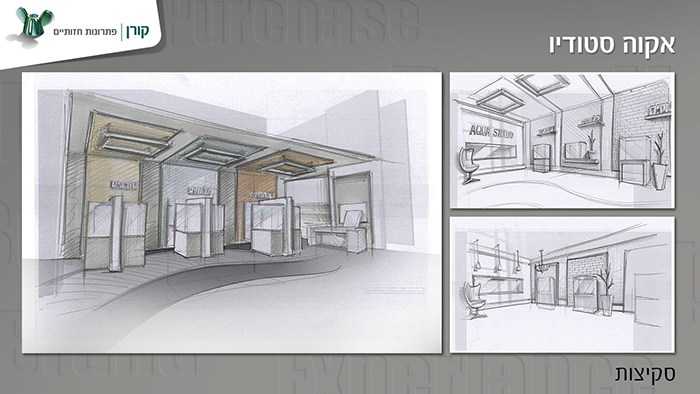 Aqua StudioSketches
Aqua StudioSketchesThe store was reopened in Herzliya Pituach [images 12-14], the name was changed to Aqua Studio and the service became a dialogue with the consultant/designer, with prices available for every budget. The store was rebranded and a website was built for the relevant target audience to show more choices beyond what is on display in the store, and to provide additional information.
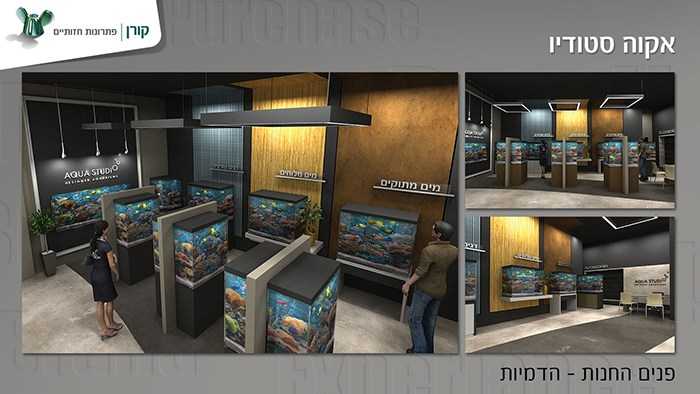 Aqua StudioStore interior – models
Aqua StudioStore interior – models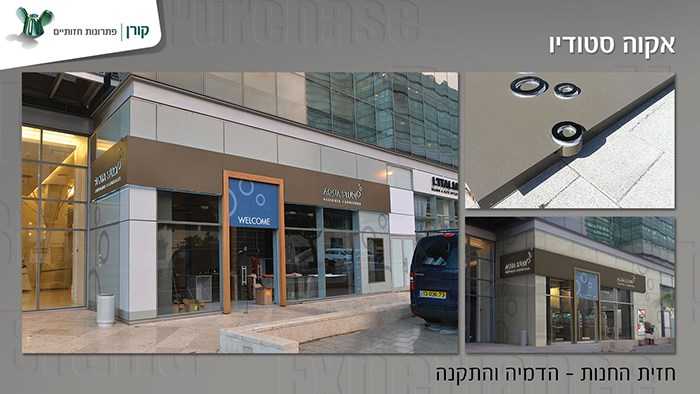 Aqua StudioThe front of the shop
Aqua StudioThe front of the shopTo sum up:
When we design retail spaces, we must understand that the designer and the planner bear considerable responsibility for the success of the space, especially today with the availability of online shopping. Unlike residential, hotel, or entertainment complexes design, retail design has its own unique rules. The designer must think first like a salesperson and plan carefully considering every detail because every decision and component in the space will affect its success.
